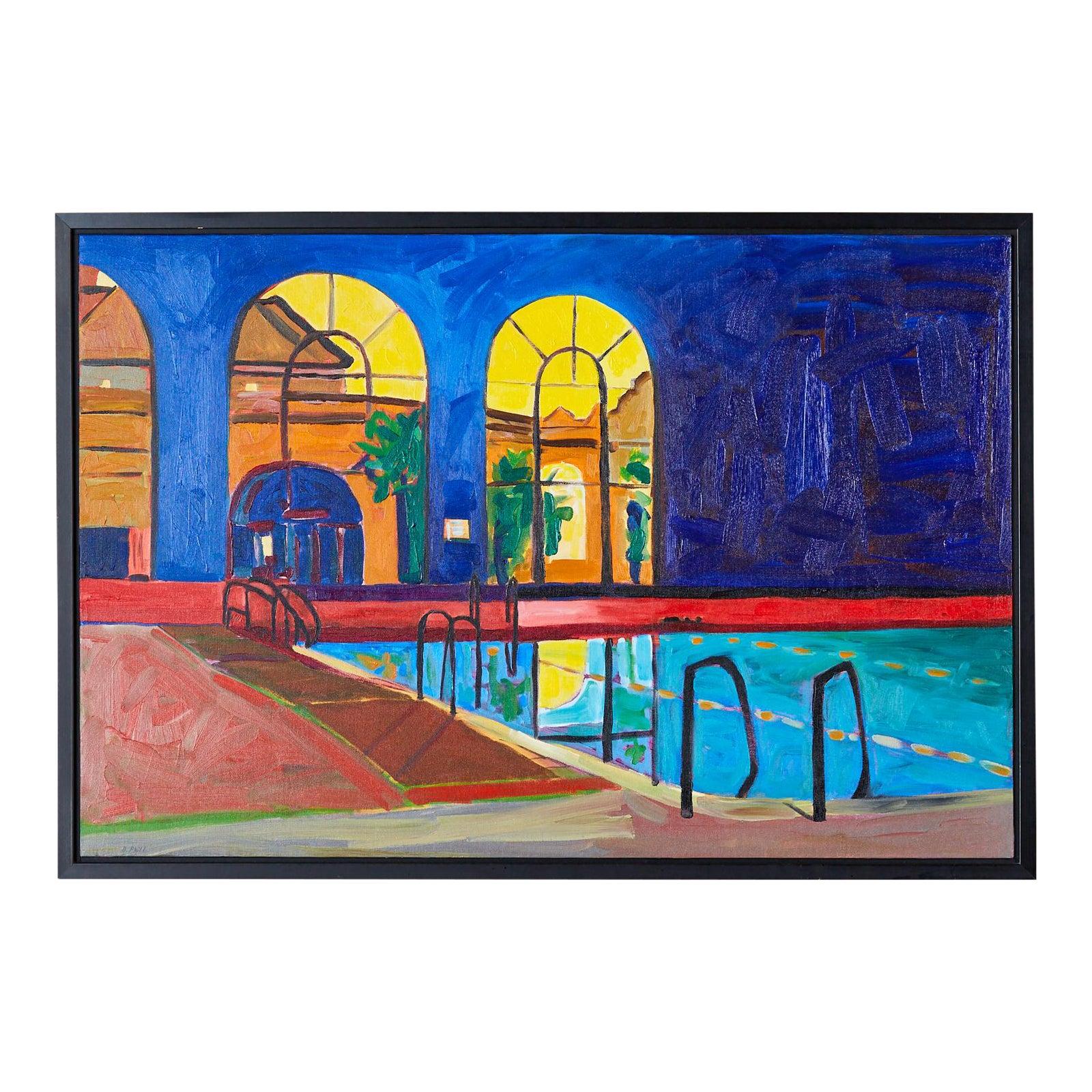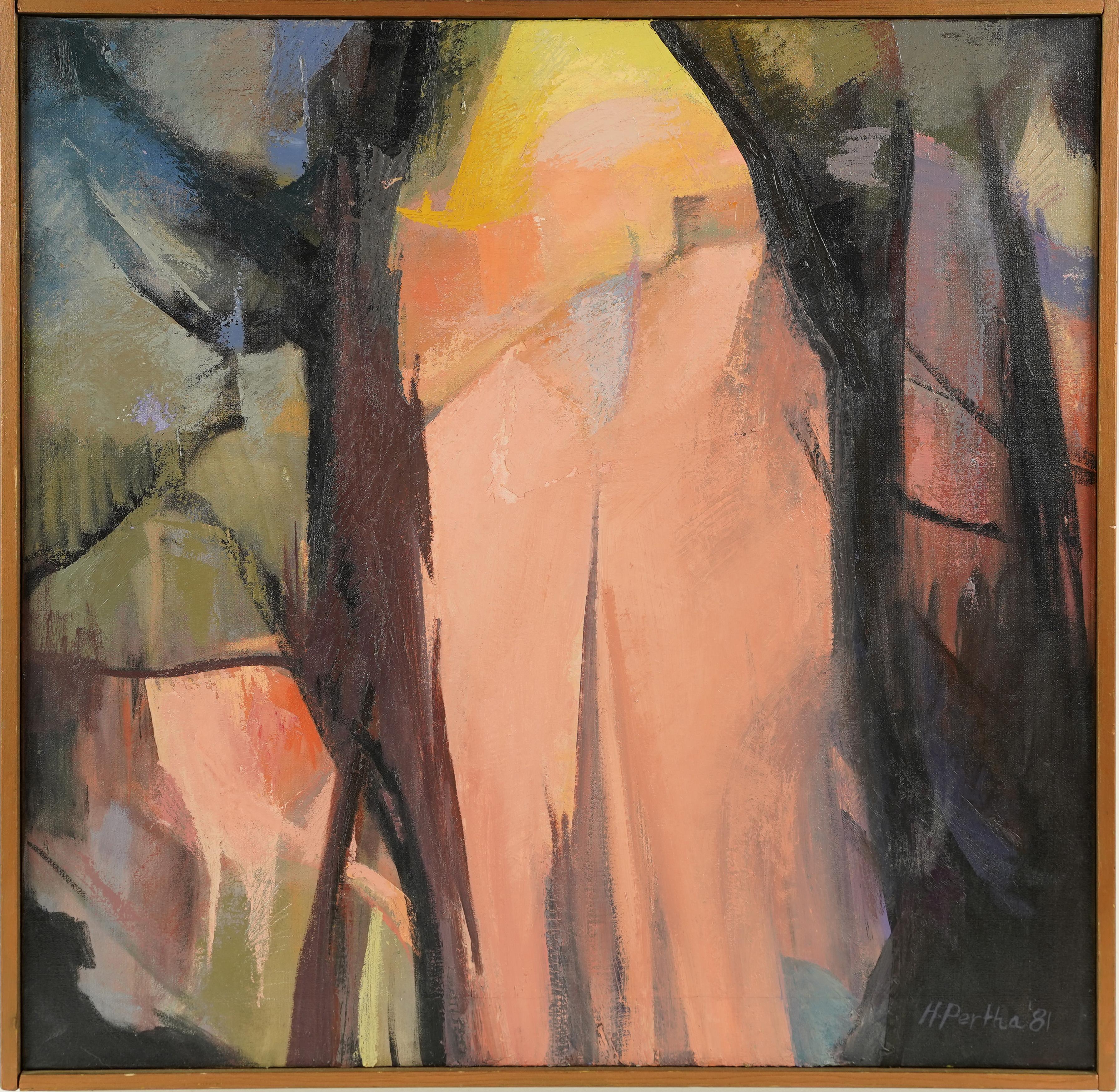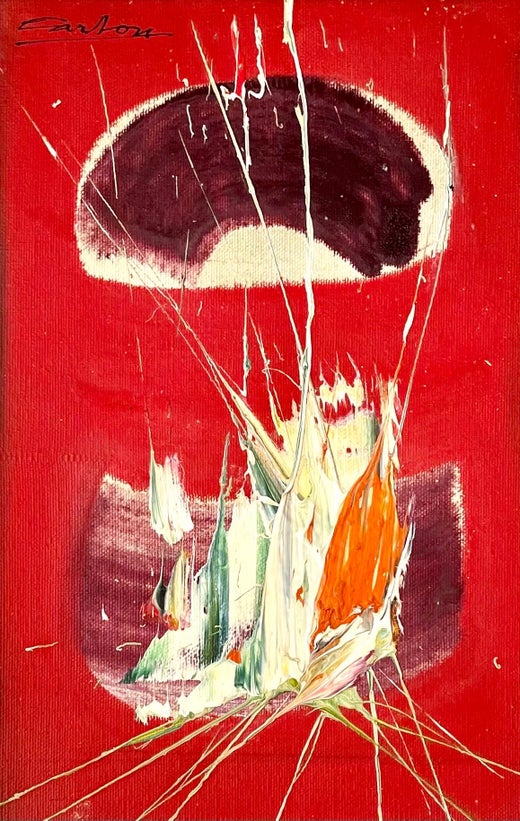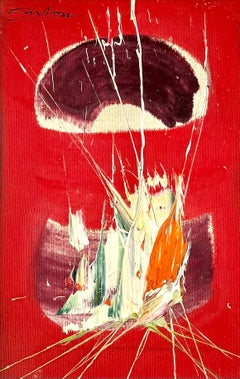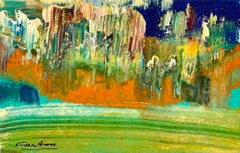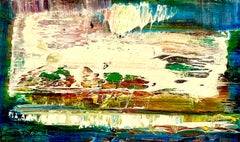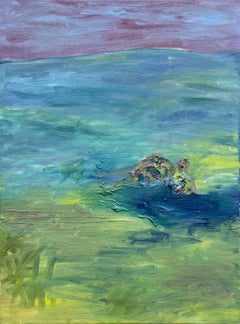Items Similar to American Vivid Abstract Expressionist Art Oil Painting Norman Carton, WPA Artist
Want more images or videos?
Request additional images or videos from the seller
1 of 7
Norman CartonAmerican Vivid Abstract Expressionist Art Oil Painting Norman Carton, WPA Artist
About the Item
Norman Carton (1908 – 1980) was an American artist and educator known for abstract expressionist art. He was born in the Ukraine region of Imperial Russia and moved to the United States in 1922 where he spent most of his adult life.
A classically trained portrait and landscape artist, Carton also worked as a drafter, newspaper illustrator, muralist, theater set designer, photographer, and fabric designer and spent most of his mature life as an art educator. Carton showed in and continues to be shown in many solo and group exhibitions. His work is included in numerous museums and private collections throughout the world.
Norman Carton was born in the Dnieper Ukraine territory of the Russian Empire in 1908. Escaping the turbulence of civil war massacres, he settled in Philadelphia in 1922 after years of constant flight. While attending the Pennsylvania Museum School of Industrial Art, Carton worked as a newspaper artist for the Philadelphia Record from 1928 to 1930 in the company of other illustrator/artists who had founded the Ashcan School, the beginnings of modern American art. From 1930 to 1935, he studied at the Pennsylvania Academy of Fine Arts under Henry McCarter, who was a pupil of Toulouse-Lautrec, Puvis de Chavanne, and Thomas Eakins. Arthur Carles, especially with his sense of color, and the architect John Harbison also provided tutelage and inspiration. Following his time at the Pennsylvania Academy of Fine Arts, Carton studied at the Barnes Foundation from 1935 to 1936 where he was influenced by an intellectual climate led by visiting lecturers John Dewey and Bertrand Russell as well as daily access to Albert C. Barnes and his art collection.
Carton was awarded the Cresson Traveling Scholarship in 1934 which allowed him to travel through Europe and study in Paris. There he expanded his artistic horizons with influences stemming from Henri Matisse, Pablo Picasso, Chaim Soutine, and Wassily Kandinsky. While at the Pennsylvania Academy of Fine Arts, Carton was also awarded the Toppan Prize for figure painting as well as the Thouron Composition Prize. He received numerous commissions as a portrait artist, social realist, sculptor, and theatrical stage designer as well as academic scholarships. During this time, Carton worked as a scenery designer at Sparks Scenic Studios, a drafter at the Philadelphia Enameling Works, and a fine art lithographer.
From 1939 to 1942, the Works Progress Administration (WPA) Federal Art Project employed Carton as a muralist and easel artist. He collaborated with architect George Howe. The WPA commissioned Carton to paint major murals at the Helen Fleischer Vocational School for Girls in Philadelphia, the Officers’ Club at Camp Meade Army Base in Maryland, and in the city of Hidalgo, Mexico. Throughout the 1940s, Carton exhibited and won prizes for his semi-abstract Expressionist and Surrealist paintings. He socialized with and was inspired by Émile Gauguin and Fernand Leger. During World War II, Carton was a naval structural designer and draftsman at the Cramps Shipbuilding Corporation in Camden, New Jersey. Here, he created non-objective sculpture with metal. After the war, Carton co-founded a fabric design plant in Philadelphia. He produced hand-printed fabrics for interiors and fashion that were featured in Harper’s Bazaar, Vogue and Women’s Wear Daily. Original fabric designs were commissioned by notable clients including Lord & Taylor, Gimbels, and Nina Ricci. Some of these designs are at the Metropolitan Museum of Art. Carton traded his partnership in the fabric design company in 1949 to focus full-time on painting. Carton had his first solo exhibition in 1949 at the Philadelphia Art Alliance. This show was followed closely by solo exhibitions at the Laurel Gallery (New York City) and Dubin Gallery (Philadelphia). At this time, his exhibited work was Abstract impressionism. In addition to painting, he taught classes at the Philadelphia Museum of Art and was the Founder and first President of the Philadelphia chapter of Artist’s Equity Association. The Philadelphia Museum of Art and the organization of the National Museums of France commissioned Carton to travel to Europe, mainly France, in 1950 for a color photography study of continental masterpieces. He was granted access to study the restoration of the Mona Lisa and was one of the very few to be given permission to remove the painting from its frame. During his three year stay in Paris, he had solo exhibits at La Sorbonne and Gallery Rene Breteau and was in 15 group shows in Paris salons including Les Sur Independants, Salon d’Automne, and Realities Nouvelles. He also exhibited at the Musee d’Art Juif where he won the Prix d’Art. The Cercle Paul Valery twice sponsored Carton to present lectures at the Sorbonne. He conducted seminars at the Louvre for the Cercle Esthetique Internationale and taught classes in and directed stage and costume design for the Theatre de Recherche at the Paris Opera. Among his Paris artist colleagues were Chana Orloff, Earl Kerkam, Sam Francis, Claire Falkenstein, Lawrence Calcagno, Norman Bluhm, and Al Held.
When Carton returned to the United States in 1953, he settled in New York City where he worked in the company of the leading artists of the day with whom he appeared in a number of group shows including the Whitney Museum of American Art's 1955-1956 “Exhibit of Contemporary American Painting.” This exhibition included such notable artists as Richard Diebenkorn, Joan Mitchell, James Brooks, Grace Hartigan, Franz Kline, Georgia O'Keeffe, Adolph Gottlieb, Robert De Niro Sr., and many others. The Whitney subsequently purchased a Carton.
The mid-1950s to the 1970s was a busy time for Carton during which he received a great deal of recognition. He had solo exhibitions one gallery after another: Martha Jackson, Staempfli, Granite and World House, New York City; Tirca Karlis, Provincetown; Gres, Washington D.C.; Dumbarton, Boston; and Joachim, Chicago.
Carton's large canvases traveled in major collections to such venues as the Smithsonian American Art Museum (was SNCFA) and the RISD Museum of Fine Arts with significant works of artists such as Jim Dine, Hans Hofmann, Robert Motherwell, Louise Nevelson, and Jackson Pollock. Other group exhibitions included Whitney, Corcoran, Phillips, Dallas, Dayton, Walker, and Chrysler Museums among others.
Among his NYC artist colleagues were also now Louise Nevelson and John Hultberg who he had helped welcome at the Martha Jackson Gallery. In 1962, with the aid of two other artists, he formed the Dewey Gallery, one of the first New York City galleries owned and operated by artists. He presented his work during the opening exhibition.
During his lifetime, Carton was in at least 150 group exhibits and more than 20 solo shows and continued to receive many PAFA fellowship awards. He was popularly and critically regarded as possessing a painterly style of superlative action and a unique knowledge as a colorist, Carton ground his own pigments and painted with a brilliant palette. More recently, he exhibited with Willem de Kooning and Mark Rothko among other greats of the Abstract Expressionism movement as well as Pablo Picasso and Henri Matisse.
Norman Carton was also an art educator throughout much of his life. Beginning in 1960, Carton worked on the art faculty at the New School where he would remain until his death. From 1948 to 1949, he taught painting and composition at the Philadelphia Museum of Art. From 1950 to 1953, he conducted seminars at the Louvre and the Sorbonne while living in Paris. Also while in Paris, Carton taught classes in and directed stage and costume design for the Theatre de Recherche at the Paris Opera. He also gave lectures at the Pratt Institute and the Chrysler Museum of Art as well as the Whitney Museum of American Art. Carton moderated panel discussions between prominent artists and educators and appeared in radio interviews. In 1960 and 1961, he painted at the MacDowell Colony in New Hampshire as a fellow. Carton also taught for a time at Long Island University.
Norman Carton has had more than 25 solo exhibitions and was part of over 175 group exhibitions. His work is currently in more than 20 museums and hundreds of private collections throughout the world.
Carton's works continue to be included in present day exhibitions including at Hollis Taggart Gallery entitled Wild and Brilliant: The Martha Jackson Gallery and Post-War Art, Quogue Gallery entitled 1950s and 1960s Works on Paper, the Nassau County Museum of Art entitled Blue in 2020 as well as Energy: The Power of Art in 2019 and at the Anita Shapolsky Gallery in 2019 entitled Inspiration & Exploration.
A representational portion of Carton's papers which include correspondence, writings, notes, exhibition catalogs and sketchbooks were donated to the Smithsonian Archives of American Art where they remain.
Selected museum collections
Albright–Knox Art Gallery, Buffalo, New York
Blanton Museum of Art, University of Texas at Austin
Chrysler Museum of Art, Norfolk VA
Fonds National d'Art Contemporain / Center National d'Arts Plastiques, Paris
Moscow Conservatory, Moscow, Russia
Musée d'art moderne (Saint-Étienne, France), 1954-1992
Musée d'Art et d'Histoire du Judaïsme, Paris, France
Museo Nacional de Bellas Artes de La Habana, Havana, Cuba
Museum of Fine Arts, Budapest, Hungary
National Gallery of Art, Washington, D.C.
Neuberger Museum of Art, Purchase, New York
Palmer Museum of Art, State College, Pennsylvania
Pennsylvania Academy of the Fine Arts, Philadelphia, Pennsylvania
Rhode Island School of Design Museum, Providence, Rhode Island
The New School Art Collection, New York, New York
Whitney Museum of American Art, New York, New York
Yale University Art Gallery, New Haven, Connecticut
- Creator:Norman Carton (1908 - 1980, American)
- Dimensions:Height: 8 in (20.32 cm)Width: 10 in (25.4 cm)
- Medium:
- Movement & Style:
- Period:
- Condition:
- Gallery Location:Surfside, FL
- Reference Number:1stDibs: LU38211765712
Norman Carton
Norman Carton was an American artist and educator known for Abstract Expressionist works in oil on canvas. While this was his most recognized style and medium, Carton was primarily a colorist and also worked as a muralist, classically trained portrait and landscape artist, sculptor, theater set and fabric designer, and illustrator as well as in a variety of abstractions. He has a large museum collection and commercial history, showing in more than 20 solo and 135 group exhibitions." He was awarded numerous awards, prizes and fellowships for painting. In the 1930s he was part of the WPA creating murals. In the 1940s, he founded a fabric design and production firm which was featured in Interiors magazine, Vogue, Harper's Bazaar, and Women's Wear Daily. These were hand-printed fabrics and his clients were Nina Ricci, Hattie Carnegie, Lord & Taylor, and others. In 1962 Norman Carton opened his own Dewey Gallery in NYC. Carton's works continue to be included in present day exhibitions including at Quogue Gallery entitled 1950s and 1960s Works on Paper,, at the Nassau County Museum of Art entitled Blue in 2020 as well as Energy: The Power of Art in 2019, and at the Anita Shapolsky Gallery in 2019 entitled Inspiration & Exploration. Norman Carton's 2020 solo exhibition at Quogue Gallery was reviewed by Charles A Riley. A representational portion of Carton's papers which include correspondence, writings, notes, exhibition catalogs and sketchbooks were donated to the Smithsonian Archives of American Art where they remain.
About the Seller
4.9
Platinum Seller
Premium sellers with a 4.7+ rating and 24-hour response times
Established in 1995
1stDibs seller since 2014
1,744 sales on 1stDibs
Typical response time: 2 hours
- ShippingRetrieving quote...Shipping from: Surfside, FL
- Return Policy
Authenticity Guarantee
In the unlikely event there’s an issue with an item’s authenticity, contact us within 1 year for a full refund. DetailsMoney-Back Guarantee
If your item is not as described, is damaged in transit, or does not arrive, contact us within 7 days for a full refund. Details24-Hour Cancellation
You have a 24-hour grace period in which to reconsider your purchase, with no questions asked.Vetted Professional Sellers
Our world-class sellers must adhere to strict standards for service and quality, maintaining the integrity of our listings.Price-Match Guarantee
If you find that a seller listed the same item for a lower price elsewhere, we’ll match it.Trusted Global Delivery
Our best-in-class carrier network provides specialized shipping options worldwide, including custom delivery.More From This Seller
View AllNell Sinton Abstract Expressionist Landscape San Francisco California Modernist
Located in Surfside, FL
Eleanor Nell Sinton
Roots and Stems 1950,
Oil on canvas,
Signed lower right N. Sinton,
Provenance: Braunstein Quay Gallery (bears label verso)
Framed: 24.5 X 20.5 sight 21 X 17 inches.
Nell (Eleanor) Sinton (1910-1997) was a painter, art collector and educator in San Francisco, California
Nell Sinton began painting in the 1920s. She studied at the San Francisco Art Institute (then called the California School of Fine Arts). Nell Sinton, one of the early California woman abstract expressionist painters.
A member of a family that moved to San Francisco in 1851, Nell Sinton began painting in the 1920s. She studied at the San Francisco Art Institute (then called the California School of Fine Arts) a decade before abstract expressionism emerged there, and, later, with Lucien Labaudt and Maurice Sterne, (1937-1938). She also worked as an apprentice to Sterne on the Federal Art Project (WPA) murals in San Francisco (1938-40) and was a member of the San Francisco Art Commission (1959-63). In 1959, Sinton was acknowledged as one of the Ten Most Distinguished Bay Area Women. A notable Bay Area Expressionist...
Category
1950s Abstract Expressionist Abstract Paintings
Materials
Canvas, Oil
American Vivid Abstract Expressionist Art Oil Painting Norman Carton, WPA Artist
By Norman Carton
Located in Surfside, FL
Norman Carton (1908 – 1980) was an American artist and educator known for abstract expressionist art. He was born in the Ukraine region of Imperial Russia and moved to the United States in 1922 where he spent most of his adult life.
A classically trained portrait and landscape artist, Carton also worked as a drafter, newspaper illustrator, muralist, theater set designer, photographer, and fabric designer and spent most of his mature life as an art educator. Carton showed in and continues to be shown in many solo and group exhibitions. His work is included in numerous museums and private collections throughout the world.
Norman Carton was born in the Dnieper Ukraine territory of the Russian Empire in 1908. Escaping the turbulence of civil war massacres, he settled in Philadelphia in 1922 after years of constant flight. While attending the Pennsylvania Museum School of Industrial Art, Carton worked as a newspaper artist for the Philadelphia Record from 1928 to 1930 in the company of other illustrator/artists who had founded the Ashcan School, the beginnings of modern American art. From 1930 to 1935, he studied at the Pennsylvania Academy of Fine Arts under Henry McCarter, who was a pupil of Toulouse-Lautrec, Puvis de Chavanne, and Thomas Eakins. Arthur Carles, especially with his sense of color, and the architect John Harbison also provided tutelage and inspiration. Following his time at the Pennsylvania Academy of Fine Arts, Carton studied at the Barnes Foundation from 1935 to 1936 where he was influenced by an intellectual climate led by visiting lecturers John Dewey and Bertrand Russell as well as daily access to Albert C. Barnes and his art collection.
Carton was awarded the Cresson Traveling Scholarship in 1934 which allowed him to travel through Europe and study in Paris. There he expanded his artistic horizons with influences stemming from Henri Matisse, Pablo Picasso, Chaim Soutine, and Wassily Kandinsky. While at the Pennsylvania Academy of Fine Arts, Carton was also awarded the Toppan Prize for figure painting as well as the Thouron Composition Prize. He received numerous commissions as a portrait artist, social realist, sculptor, and theatrical stage designer as well as academic scholarships. During this time, Carton worked as a scenery designer at Sparks Scenic Studios, a drafter at the Philadelphia Enameling Works, and a fine art lithographer.
From 1939 to 1942, the Works Progress Administration (WPA) Federal Art Project employed Carton as a muralist and easel artist. He collaborated with architect George Howe. The WPA commissioned Carton to paint major murals at the Helen Fleischer Vocational School for Girls in Philadelphia, the Officers’ Club at Camp Meade Army Base in Maryland, and in the city of Hidalgo, Mexico. Throughout the 1940s, Carton exhibited and won prizes for his semi-abstract Expressionist and Surrealist paintings. He socialized with and was inspired by Émile Gauguin and Fernand Leger. During World War II, Carton was a naval structural designer and draftsman at the Cramps Shipbuilding Corporation in Camden, New Jersey. Here, he created non-objective sculpture with metal. After the war, Carton co-founded a fabric design plant in Philadelphia. He produced hand-printed fabrics for interiors and fashion that were featured in Harper’s Bazaar, Vogue and Women’s Wear Daily. Original fabric designs were commissioned by notable clients including Lord & Taylor, Gimbels, and Nina Ricci. Some of these designs are at the Metropolitan Museum of Art. Carton traded his partnership in the fabric design company in 1949 to focus full-time on painting. Carton had his first solo exhibition in 1949 at the Philadelphia Art Alliance. This show was followed closely by solo exhibitions at the Laurel Gallery (New York City) and Dubin Gallery (Philadelphia). At this time, his exhibited work was Abstract impressionism. In addition to painting, he taught classes at the Philadelphia Museum of Art and was the Founder and first President of the Philadelphia chapter of Artist’s Equity Association. The Philadelphia Museum of Art and the organization of the National Museums of France commissioned Carton to travel to Europe, mainly France, in 1950 for a color photography study of continental masterpieces. He was granted access to study the restoration of the Mona Lisa and was one of the very few to be given permission to remove the painting from its frame. During his three year stay in Paris, he had solo exhibits at La Sorbonne and Gallery Rene Breteau and was in 15 group shows in Paris salons including Les Sur Independants, Salon d’Automne, and Realities Nouvelles. He also exhibited at the Musee d’Art Juif where he won the Prix d’Art. The Cercle Paul Valery twice sponsored Carton to present lectures at the Sorbonne. He conducted seminars at the Louvre for the Cercle Esthetique Internationale and taught classes in and directed stage and costume design for the Theatre de Recherche at the Paris Opera. Among his Paris artist colleagues were Chana Orloff, Earl Kerkam, Sam Francis, Claire Falkenstein, Lawrence...
Category
Mid-20th Century Abstract Expressionist Landscape Paintings
Materials
Canvas, Oil
American Vivid Abstract Expressionist Art Oil Painting Norman Carton, WPA Artist
By Norman Carton
Located in Surfside, FL
Norman Carton (1908 – 1980) was an American artist and educator known for abstract expressionist art. He was born in the Ukraine region of Imperial Russia and moved to the United States in 1922 where he spent most of his adult life.
A classically trained portrait and landscape artist, Carton also worked as a drafter, newspaper illustrator, muralist, theater set designer, photographer, and fabric designer and spent most of his mature life as an art educator. Carton showed in and continues to be shown in many solo and group exhibitions. His work is included in numerous museums and private collections throughout the world.
Norman Carton was born in the Dnieper Ukraine territory of the Russian Empire in 1908. Escaping the turbulence of civil war massacres, he settled in Philadelphia in 1922 after years of constant flight. While attending the Pennsylvania Museum School of Industrial Art, Carton worked as a newspaper artist for the Philadelphia Record from 1928 to 1930 in the company of other illustrator/artists who had founded the Ashcan School, the beginnings of modern American art. From 1930 to 1935, he studied at the Pennsylvania Academy of Fine Arts under Henry McCarter, who was a pupil of Toulouse-Lautrec, Puvis de Chavanne, and Thomas Eakins. Arthur Carles, especially with his sense of color, and the architect John Harbison also provided tutelage and inspiration. Following his time at the Pennsylvania Academy of Fine Arts, Carton studied at the Barnes Foundation from 1935 to 1936 where he was influenced by an intellectual climate led by visiting lecturers John Dewey and Bertrand Russell as well as daily access to Albert C. Barnes and his art collection.
Carton was awarded the Cresson Traveling Scholarship in 1934 which allowed him to travel through Europe and study in Paris. There he expanded his artistic horizons with influences stemming from Henri Matisse, Pablo Picasso, Chaim Soutine, and Wassily Kandinsky. While at the Pennsylvania Academy of Fine Arts, Carton was also awarded the Toppan Prize for figure painting as well as the Thouron Composition Prize. He received numerous commissions as a portrait artist, social realist, sculptor, and theatrical stage designer as well as academic scholarships. During this time, Carton worked as a scenery designer at Sparks Scenic Studios, a drafter at the Philadelphia Enameling Works, and a fine art lithographer.
From 1939 to 1942, the Works Progress Administration (WPA) Federal Art Project employed Carton as a muralist and easel artist. He collaborated with architect George Howe. The WPA commissioned Carton to paint major murals at the Helen Fleischer Vocational School for Girls in Philadelphia, the Officers’ Club at Camp Meade Army Base in Maryland, and in the city of Hidalgo, Mexico. Throughout the 1940s, Carton exhibited and won prizes for his semi-abstract Expressionist and Surrealist paintings. He socialized with and was inspired by Émile Gauguin and Fernand Leger. During World War II, Carton was a naval structural designer and draftsman at the Cramps...
Category
Mid-20th Century Abstract Expressionist Landscape Paintings
Materials
Canvas, Oil
American Vivid Abstract Expressionist Art Oil Painting Norman Carton, WPA Artist
By Norman Carton
Located in Surfside, FL
Norman Carton (1908 – 1980) was an American artist and educator known for abstract expressionist art. He was born in the Ukraine region of Imperial Russia and moved to the United States in 1922 where he spent most of his adult life.
A classically trained portrait and landscape artist, Carton also worked as a drafter, newspaper illustrator, muralist, theater set designer, photographer, and fabric designer and spent most of his mature life as an art educator. Carton showed in and continues to be shown in many solo and group exhibitions. His work is included in numerous museums and private collections throughout the world.
Norman Carton was born in the Dnieper Ukraine territory of the Russian Empire in 1908. Escaping the turbulence of civil war massacres, he settled in Philadelphia in 1922 after years of constant flight. While attending the Pennsylvania Museum School of Industrial Art, Carton worked as a newspaper artist for the Philadelphia Record from 1928 to 1930 in the company of other illustrator/artists who had founded the Ashcan School, the beginnings of modern American art. From 1930 to 1935, he studied at the Pennsylvania Academy of Fine Arts under Henry McCarter, who was a pupil of Toulouse-Lautrec, Puvis de Chavanne, and Thomas Eakins. Arthur Carles, especially with his sense of color, and the architect John Harbison also provided tutelage and inspiration. Following his time at the Pennsylvania Academy of Fine Arts, Carton studied at the Barnes Foundation from 1935 to 1936 where he was influenced by an intellectual climate led by visiting lecturers John Dewey and Bertrand Russell as well as daily access to Albert C. Barnes and his art collection.
Carton was awarded the Cresson Traveling Scholarship in 1934 which allowed him to travel through Europe and study in Paris. There he expanded his artistic horizons with influences stemming from Henri Matisse, Pablo Picasso, Chaim Soutine, and Wassily Kandinsky. While at the Pennsylvania Academy of Fine Arts, Carton was also awarded the Toppan Prize for figure painting as well as the Thouron Composition Prize. He received numerous commissions as a portrait artist, social realist, sculptor, and theatrical stage designer as well as academic scholarships. During this time, Carton worked as a scenery designer at Sparks Scenic Studios, a drafter at the Philadelphia Enameling Works, and a fine art lithographer.
From 1939 to 1942, the Works Progress Administration (WPA) Federal Art Project employed Carton as a muralist and easel artist. He collaborated with architect George Howe. The WPA commissioned Carton to paint major murals at the Helen Fleischer Vocational School for Girls in Philadelphia, the Officers’ Club at Camp Meade Army Base in Maryland, and in the city of Hidalgo, Mexico. Throughout the 1940s, Carton exhibited and won prizes for his semi-abstract Expressionist and Surrealist paintings. He socialized with and was inspired by Émile Gauguin and Fernand Leger. During World War II, Carton was a naval structural designer and draftsman at the Cramps...
Category
Mid-20th Century Abstract Expressionist Landscape Paintings
Materials
Canvas, Oil
Abstract Expressionist Landscape Israeli Modernist Oil Painting, Moody Blue
By Shimon Avny
Located in Surfside, FL
Shimon Avni
Shimon Avny, painter, born 1932, Paris
Shimon Avny (Stein) was born in Paris, France. He grew up in the Belville neighborhood. In 1942, when the Nazis occupied France, he was separated from his family. His mother and brothers were killed in the Holocaust. After the war, he was transferred from his hiding place to the town of Andlis. He immigrated to Israel with Youth Aliyah in 1948. In 1956, he joined Kibbutz Ra'im. In 1957, he studied painting with Joseph Zaritsky, Avigdor Stematzky and Haim Kiewe. He also studied with Yehezekel Streichman at the Avni Institute. At the end of the 1950s, he went to Paris to continue his studies. In the 1980s, he joined the Radius artists cooperative.
Avny's early work was influenced by the abstractionism of the New Horizons group. In 1963, he took part in the group's exhibition at Ein Harod. His work is characterized by bold colors, expressive brushstrokes and flat planes. He is a figurative painter, but some of his work incorporates symbolic imagery.
Education
1957 Painting with Joseph Zaritsky, Avigdor Stematsky and Haim Kiewe
Avni Institute, Tel Aviv, with Yehezkel Streichman
Grande Chaumiere Academy, Paris, 1958
Ecole des Beaux Arts, Paris, 1961
Fine Arts Academy, Rome
Photography and television, Paris, 1965-67
Teaching
Lectured abroad for the Ministry of Education and Culture, 1969-71
Bezalel Academy, Jerusalem, painting, 1974-78
College of Visual Arts, Beersheba, 1975-81
Headmaster of the Art Institute, Rehovot, 1975-85
1981-85 and 1988-92 Art Teachers College, Ramat Hasharon
Since1992 Avni Institute, Tel Aviv, Teacher and coordinator of the Arts Department
Awards And Prizes
1975 The America-Israel Cultural Fund Scholarship
1985 Scholarship, The Cité Internationale des Arts, Paris, France
1993 The America-Israel Cultural Foundation, Sharett Fund Scholarship for a Young Artist.
A member of the Aclim Group, which was organized in 1974. The group was established in the wake of the Yom Kippur War to point to the necessity of raising the public's consciousness of its Israeli identity in all cultural spheres. Participants in the group's exhibitions until 1983 were: Eliyahu Gat, Rahel Shavit, Ori Reisman, Avram Rafael, Michael Gross, Hannah Levy...
Category
Mid-20th Century Abstract Expressionist Abstract Paintings
Materials
Jute, Oil
Mod Abstract Expressionist Modernist Oil Painting Edward Avedisian Color Circles
By Edward Avedisian
Located in Surfside, FL
Edward Avedisian ( 1936-2007 )
17.5 X 8.75
Oil paint on wood panel
This is not signed on front. It bears his name verso.
Provenance: Hudson, N.Y. estate of noted Art Collector Alber...
Category
1960s Abstract Expressionist Landscape Paintings
Materials
Oil, Wood Panel
You May Also Like
"Pool" Oil on Canvas Painting
By Daniel Phill
Located in Rio Vista, CA
A rare departure from Daniel Phill's abstract expressionist botanical paintings titled "Pool". Interior scene of an indoor pool painted with his saturated ...
Category
20th Century Abstract Expressionist Landscape Paintings
Materials
Canvas, Oil
$2,240 Sale Price
20% Off
City Sketches 1
Located in Zofingen, AG
This piece is a vibrant dance of colors and forms, mingling abstract and impressionistic touches with a dash of symbolism. Created with acrylics, oils, oil pastels, and colored penci...
Category
2010s Abstract Expressionist Abstract Paintings
Materials
Oil, Acrylic, Canvas
Body in the Field #3 - 21st Century, abstract painting, landscape, green, blue
By Zsolt Berszán
Located in Baden-Baden, DE
Body in the Field #3, 2021
oil on canvas
31 1/2 H x 23 5/8 W in.
80 H x 60 W cm
Zsolt Berszán embodies in his works the dissolution of the human body through the prism of the fragme...
Category
2010s Abstract Expressionist Abstract Paintings
Materials
Canvas, Oil
Landscape with red trees cardboard/oil, 67x72 cm
Located in Riga, LV
Aleksandr Rodin (1922-2001)
Painter Born in a family of farmers. Wife Rasma Lace - art scholar. Studied at the Stalingrad School of Art, Saratov Art School, graduated from the Depar...
Category
1990s Abstract Expressionist Landscape Paintings
Materials
Canvas, Oil
Clear Skies, NYC-Original Abstract cityscape-landscape painting-contemporary Art
By Alex Hook Krioutchkov
Located in London, Chelsea
This exceptional artwork is currently on display and available for sale at Signet Contemporary Art Gallery and online.
Embark on a visual journey through the waters of New York City...
Category
21st Century and Contemporary Abstract Expressionist Abstract Paintings
Materials
Canvas, Oil
Antique American Large Female Abstract Expressionist Sunset Landscape Painting
Located in Buffalo, NY
Vintage signed American abstract landscape oil painting. Oil on canvas. Signed. Framed. Image size, 24L x 24H.
Category
1980s Abstract Expressionist Landscape Paintings
Materials
Canvas, Oil
$1,036 Sale Price
20% Off
Recently Viewed
View AllMore Ways To Browse
Structural Art
American Designer Paris
American Civil War Art
Russian Art 1930
Picasso Inspired Oil In Canvas Paint
French Empire Paintings
1940s Paintings Women
20th C Russian Art
1950s French Women Paintings Of
Art American Post Impressionism
Georgian House Painting
Mid Century Enamel Painting
Naval Oil Paintings
Thomas Hand Oil Painting
Painting Oil Earl
Wpa Lithograph
Russian Empire Painting
Taylor Vintage Landscape
